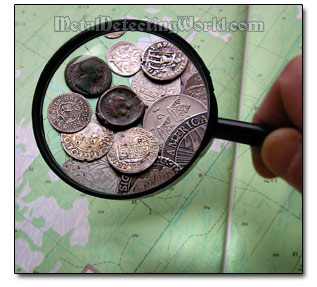Want to learn how to conduct metal detecting research - a key to successful treasure hunting? Here is my inclusive guide with tutorials!
by Sergei UpstateNY, last time modified:
This guide will teach you how to obtain good leads to productive metal detecting sites through map research, footwork and observation, archives and online research, and other ways. Success depends on the time and effort invested!

Metal Detecting Research
Introduction
To get the best results in metal detecting, a detectorist must be armed with one of the important components of successful metal detection - knowledge of good places to search.
Just like in any successful real estate business, "location, location and location!" is the key principle in serious metal detecting. That means "research, research and research!"
Without serious research, a metal detectorist cannot obtain any good leads to the never-searched and, therefore, "fruitful" locations. So the detectorist ends up detecting at the well-known, frequently visited and the so-called "hunted-out" sites, and competing with other detectorists who are doing the same. Such a passive approach to pursuing the hobby only results in wasting a lot of time and effort for recovering only fewer and mediocre finds.
Theoretically, a good site to metal detect is an area that was or has been utilized (trade, business, recreation, etc.) by either a few people over a long period of time, or by thousands over a brief period of time. In reality, the best hunt sites are the ones that have not seen many detectorists or, even better, have not been searched at all. Research, now more than ever, is essential for finding such good sites and getting true rewards for substantial time and efforts put into the process.
The metal detecting research includes map analysis (map research), archival studies (also the Internet and electronic libraries), interviewing the old-timers and their relatives, etc. The final stage of every research project is a thorough field-survey (footwork) of the site that has been identified as potential by conducting preceding research methods.
Out of many forms of research, including archival studies, used to find either a specific type or just any common type of hunt sites, basic map research and footwork are easy to conduct, quite effective and do not require special skills. This guide is mainly focusing on these two basic research methods which would get you started and help you get satisfactory results.
Some enthusiasts might argue that these methods conceptualize the search for the "obvious", and partially it is true. But in many cases, the productive sites are simply overlooked by everybody who considers them the apparent and easily accessible and, therefore, "hammered out", and turns away from them.
A few other types of research are explained in the final chapter of this guide. Please feel free to submit your own practical tips and advices that could help others!
NOTE: Although this guide to researching for "fruitful" hunt sites was created a long while ago - in 2008, it is not outdated because it describes research methods that have been, are and will always be relevant. In fact, for decades, these methods have been the only effective means to obtain good leads to productive hunt sites not known to others, and to locate such sites. And nothing new has been invented to substitute them.
Recently, various online map services and smartphone map applications with an assortment of useful features have become available to detectorists. The map services can assist in comparing old maps with new ones. The map apps assist in research, exploration and pinpointing the researched, promising locations since, for example, they can show boundaries of private properties and their owners' names on the topo map, as well as your exact position on it in real time. By using these apps, one can conduct the map research and area exploration much faster and easier than ever; however, these tools only complement the fundamental methods of finding places for metal detection and deserve a separate article. These are the reasons why these novelties are not covered in this guide.
Above is a Table of Contents to help you navigate through many sections of this inclusive guide.
